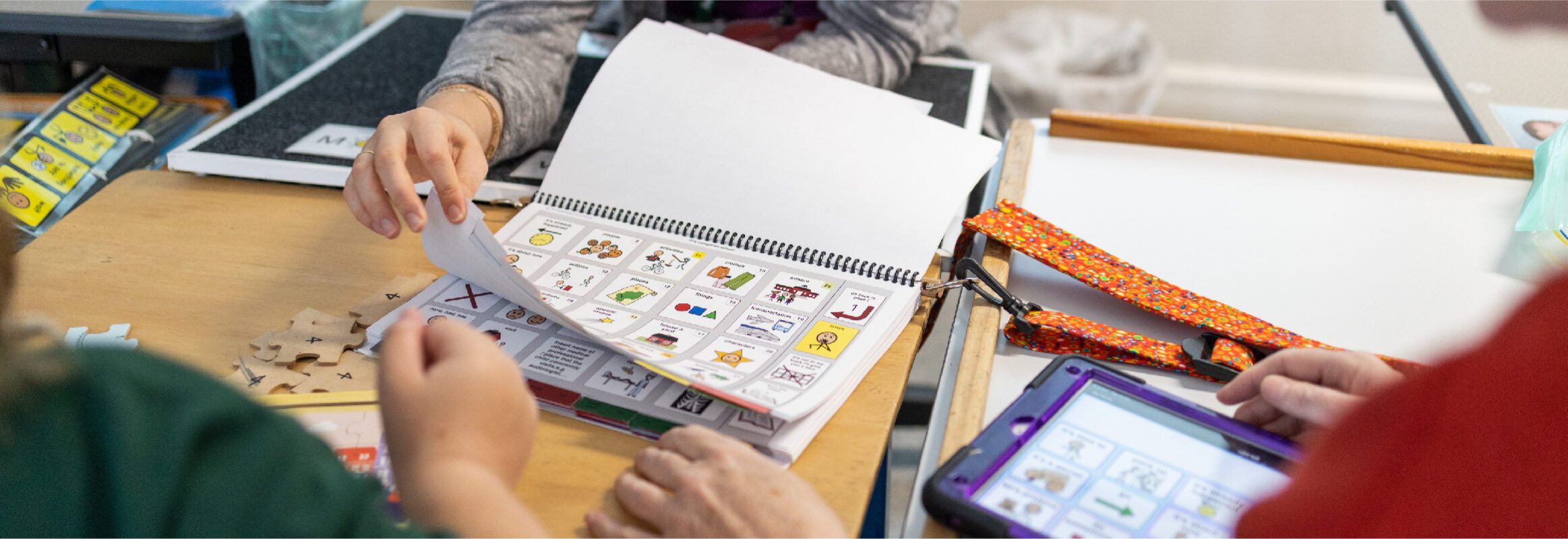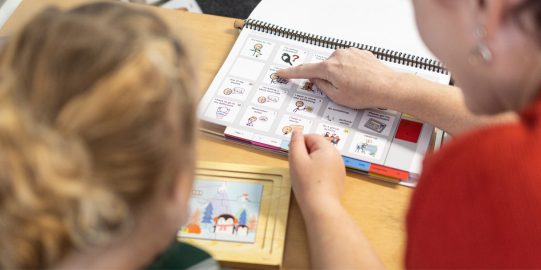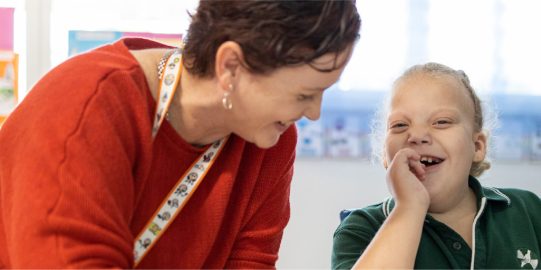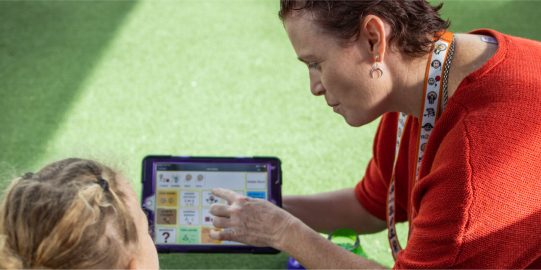My daughter’s first real AAC was Proloquo2Go. We knew she needed to have it always in arm’s length. We tried a variety of camera and binocular harnesses to mount her iPad so it was always there when she needed it. Harnesses allowed her to carry it hands-free. Every morning, we put the harness on Maggie as part of her morning routine. As long as Maggie wore her iPad, we had her AAC on hand.
I was slow to realize this wasn’t enough. I needed her AAC on me as much as she did! I probably needed it more, because Maggie needed us to show her how to use it. I had her AAC on my iPhone, but even that wasn’t enough. I finally got a second iPad, just for me. I found a case where I could attach a carry strap so that I could wear it hands-free. If I had to reach for and turn on a device, then I didn’t use it nearly as often. What I did model was just information, like “TIME to GO to bed.”
I discovered that I prefer to use a paper version of Maggie’s AAC. When I print out her communication system as a paper book, it is always ready. The battery never has to be charged. The screen is always turned on and bright. It is never open in the wrong app. I don’t even have to turn it on. The symbols are always visible, reminding me to use them.
Sometimes, I use Maggie’s digital AAC. It weighs a lot less than her paper book! Sometimes I carry the iPad version just to give my shoulders a break from the weight of her paper book. Another advantage of her digital app is that she has more support to understand me. With her digital AAC app, the message appears in the message window. The symbols stay there. Maggie can SEE the symbols I’ve used. She is very visual and often pays more attention to things that are visual than spoken. Maggie’s iPad speaks the message and repeats it.
Integrating PODD in daily life
When we switched to PODD, I printed the first draft of the book on thick paper. I didn’t bother to laminate the paper book because I knew it wasn’t our final draft. I had it bound in a printshop at an office supply store, with a spiral binding. I tried a variety of carry straps. In the end, the best solution was a scarf! I threaded it through the spiral binding and tied a knot at the right length. It is pretty and comfortable. I needed to make it a habit to wear my AAC. In the beginning, I clipped my AirPod case to the book. I’m always listening to podcasts, and I was already in the habit of carrying my phone and AirPods. Attaching these to my PODD book helped me remember to carry the book. Outside the house, I attached my car keys to the paper PODD book so that I wouldn’t forget it when leaving. I grab my PODD the way I grab my phone and keys. I try to carry her AAC even if Maggie is not with me. It’s been the only way to make carrying her AAC truly a habit.
Emergency back-ups
I also printed some half-size PODD books. I keep one in Maggie’s bedroom and one in the car. We made copies for her dad, sister, best friend, her aide at school, and her home support staff. These are emergency back-ups, just in case, the book is ever left behind. I didn’t laminate these mini-books. I just made them small and portable.
If I have my AAC, I use my AAC
When I wear Maggie’s AAC, I can’t help but use it. The symbols are right there for the whole world to see! Strangers like to approach and comment on Maggie’s curly copper hair. Maggie has often ignored people who comment on her hair. Before I had a paper version of her AAC, I would just thank them for the compliment. It seemed impossible to do more in these quick moments with strangers. But after I had her paper PODD, I started to say, “Maggie, did you HEAR that? This woman has MORE TO SAY, she LIKES THIS, she thinks your hair is BEAUTIFUL.” The entire dynamic changed. Now Maggie was part of the conversation. The pace slowed down and Maggie could follow what was happening. When I say this message on her AAC, Maggie often smiles and touches her hair. Strangers see how they can talk with HER. I realized that Maggie wasn’t trying to ignore these strangers. She just couldn’t engage with unfamiliar people who appear (and vanish again) so quickly. My paper version of her AAC has become a way I help other people talk WITH Maggie. With my copy of her AAC, I don’t have to talk FOR her.
Maggie does not need to use her AAC if she doesn’t want to. It is her choice when and how to use it. But it needs to be there, ready to be used, when she does want to use it. If it’s not there, it's like telling her I think she has nothing to say. Maggie spent much of life learning that because she cannot talk, and is not expected to say anything. Now we are teaching the opposite. We are showing Maggie HOW she can talk. Maggie doesn’t use her AAC often yet, so it needs to be ready for her on those precious occasions when she reaches for it!
simPODD has lots of options for which paper book to print. It’s up to you whether to print your paper book or just focus on the digital app. What matters is that you have it available. When you see me, I want you to see my simPODD.




